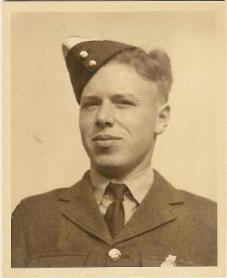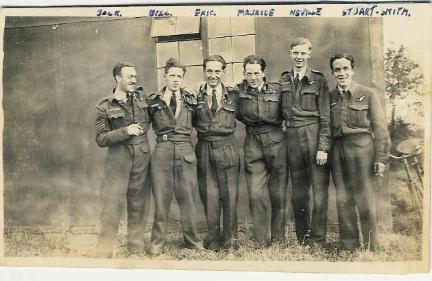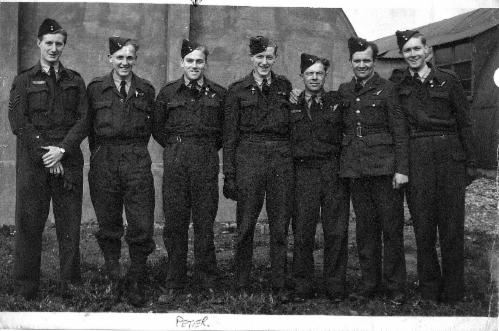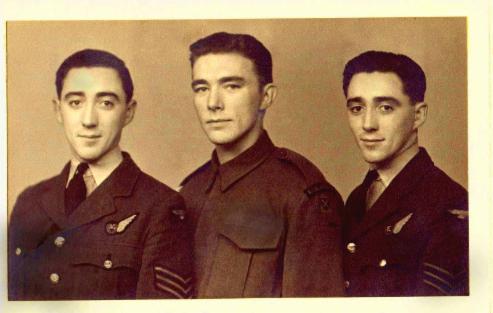Crew Stories
From John Saddler, nephew of Sergeant Navigator W G F Saddler of 514 Squadron, killed in action 70 years ago on 26 November 1943 with the crew of Lancaster DS814
Sergeant Bill Saddler, Navigator, RAFVR


From second on the left: Bill Saddler (Navigator), Eric Michell (Wireless Operator), Maurice Cantin (Pilot), Neville Walne (Air Gunner), Stuart Smith (Air bomber). The figure on the left named Jock was not one of the crew on the night the plane was lost. In fact a different Engineer flew with the crew on their only earlier mission and was replaced for Berlin so he escaped death that night only to be killed on a later mission.It is thought that the photo was taken by the seventh crew member, William Mitchell, and that the location was RAF Foulsham. The crew spent only three days at RAF WAterbeach.
The listings below are of the seven crew members of Lancaster DS814 that took off from RAF Waterbeach 70 years ago to the day. They never returned and were among the first casualties taken by 514 Squadron. The names and other details are exactly as recorded in the cemetery register at the British and Commonwealth Second World War Cemetery in Berlin which I visited last year for the first time and again this year.
DS814 was one of eight aircraft from the squadron to take off at around 5.50pm on 26 November 1943 to join a total force of 443 Lancasters in one of the biggest raids on Berlin to that point. They initially headed for Frankfurt on a decoy run before turning towards the German capital where weather conditions were unexpectedly clear with a great deal of activity from anti-aircraft flak stations and night fighters.
My uncle’s plane was on its way home when it was coned by searchlights to the northwest of the city. Unable to escape, it was eventually hit by anti-aircraft fire, exploded and came down in pieces in woods close to the village of Germendorf.
The next morning villagers found the wreckage strewn over a wide area. The bodies of all seven crew were retrieved and taken for burial in the churchyard at Germendorf where they lay until after the war when they were exhumed and reburied in the Berlin war cemetery.
I of course never knew Uncle Bill, and never had a chance to call him by that or any other name. But as I find out more about him, he becomes more familiar and I feel I can refer to him in that way. This was the crew’s first major operation and their last. All their months of training came to this – one bomb-load dropped successfully, or as far as can be told, on target. They were all very young men in their late teens and early twenties apart from the middle upper gunner Leslie Eyre, a 36 year-old with a wife and family.
Uncle Bill was 20 when he died and my father, his eldest brother and older than him by 10 years, never once spoke of him in my hearing. So it wasn’t explained to me as a boy what a hero Bill had been simply to pull on his flight hat and headset, step into that Lancaster and take off into a dark Cambridgeshire night. No doubt there were back slaps and good lucks said among the crew before they climbed on board. This was the test they’d been waiting for, but they must have known there was a fifty-fifty chance they wouldn’t come back.
My father never told me about any of this because I don’t think he could face it. But on the 26th November 1983, he and my Uncle Norman placed an ‘In Memoriam’ notice in the Daily Telegraph to mark the 40th anniversary of their younger brother’s death. I found that notice cut out and placed in a brown envelope in an old leather suitcase that was among my father’s possessions when he died. I think that says it all about how my father felt. That’s why 30 years later I’m doing the same thing and using this superb website to pay tribute to my Uncle Bill, to his crew and to all the brave airmen of 514 Squadron commemorated here. I’m also now doing what I can to find out more about Bill’s story and what the young man that you see in these photographs was really like.
If any relatives of any of the crew members named below read this, please contact me through this Facebook page. I’d really like to hear from you or anybody else who can give me any information at all about my uncle or any family background about members of the crew. Similarly do get in touch if you’d like to follow up anything that you have come across in what I have written here.
CANTIN, Flying Officer (Pilot) MAURICE RAOUL, J/20214, 514 (R.A.F.) Sqdn., Royal Canadian Air Force, 26 November 1943. Age 21. Son of Amedee J. Cantin, and of Julienne M. Cantin (nee Daudin), of McCreary, Manitoba, Canada. Grave Ref. 9, D.16.
SMITH, Flight Sergeant (Air Bomber), STUART ELMER, R/161620 514 (R.A.F.) Sqdn., Royal Canadian Air Force. 26 November 1943. Grave Ref. 9.D.17
EYRE, Sergeant (Air Gnr,) LESLIE FRANK,. 928328, 514 Sqdn., Royal Air Force Volunteer Reserve. 26 November 1943. Age 36. Son of Frank E. Eyre and Ada R. Eyre; husband of Catherine Beckett Eyre, of Framlingham, Suffolk, Grave Ref.9.D.18.
WALNE, Sergeant (Air Gnr.) ROBERT NEVILLE, 1287750, 514 Sqdn., Royal Air ForceVolunteer Reserve, 26 November 1943. Age 20, Son of Capt. H. A. Walne, Mrs. Walne, of Framlingham. Suffolk. Grave Ref. 9, D.19.
KING, Sergeant (Flt.Engr,) KERRY GEORGE, 57708, 514 Sqdn., Royal Air Force, 26 November 1943. Age 19. Son of Francis P. King and Henrietta Mary King, of Yiewsley, West Drayton, Middlesex. Grave Ref. 9,D.20.
MICHELL, Sergeant (W.Op./Air Gnr.) WILLIAM ERIC THOMAS, 1388185, 514 Sqdn.,Royal Air Force Volunteer Reserve. 26 November 1943. Age 22. Son of Nellie Michell, of Tunbridge Wells, Kent. Grave Ref. Joint Grave 9.D.21-22.
SADDLER, Flight Sergeant (Nav.) WILLIAM GEORGE FYFE, 1346909, 514 Sqdn., Royal Air Force Volunteer Reserve, 26 November 1943. Age 20. Son of Archibald and Helen Gordon Fyfe Saddler, of Forfar, Angus. Grave Ref. Joint grave 9.D. 21-22.
From Simon Hepworth, great-nephew of Sgt. Peter Gosnold who was killed in action with four crew mates on 21st November 1944, over Homberg in PD265 JI-G.
F/O Geoffrey France and Crew
F/O GC France - Pilot POW
F/O FJ Eisberg -Navigator POW
F/O KH Barker RCAF - Bomb Aimer KIA
Sgt. RWI Harding -WOP/Air Gunner KIA
F/O P Slater - MU Gunner KIA
Sgt. RP Coles - Rear Gunner KIA
Sgt. PA Gosnold - Flight Engineer KIA

Left to right: Sgt. Ronald Hardy (WOP/AG), Sgt. Les Coles (Rear Gunner), Sgt. Peter Gosnold (Flight Engineer), F/O Geoffrey France (Pilot), F/O Kenneth Barker RCAF (Bomb Aimer), Sgt. William Meredith (MU Gunner - left crew 31/10/44), F/O Frederick Eisberg (Navigator).
For a while, the France crew was allocated LM277, JI-F until the aircraft was lost with the crew of F/O Arkless attacking Calais. LM733 was assigned the code JI-F and the France crew continued to use that aircraft intermittently. For the most part, however, they seem to have taken different aircraft on each operation. The crew was trained in the use of G-H special equipment, acting as G-H Leader on a number of flights.
The crew was told that they would be screened off operations after 35 ops. Their 34th was on 21st November 1944. The target, once again, was the Rhein-Preussen synthetic oil plant at Homberg, on the outskirts of Moers and just across the Rhine from Duisburg. The oil plant was strenuously defended, with heavy flak units being deployed around the area. In particular, the Grossbatterie Daubenspeckhof unit was sited 1 km NW of Moers and close to the run in to the target.
G-H bombing required a long and steady approach to ensure accuracy, making the approaching aircraft more vulnerable to flak defences. To make matters worse, the promised cloud cover cleared as the force approached the target. The France crew, in PD265, JI-G on this occasion, had just bombed when a flak shell exploded on the aircraft’s starboard side, killing Sgt Peter Gosnold almost instantly. More shells hit the Lancaster which was critically damaged, going immediately into a dive. Geoff France remembered bracing his feet against the instrument panel as he tried to pull the aircraft back onto an even keel, but without success. Fortunate to be wearing their parachutes when the aircraft was hit, Geoff France and Freddie Eisberg were thrown clear, the pilot watching on as his aircraft, by now missing its tail unit, plummeted to earth. The pilot and navigator were the only survivors.
The aircraft, according to local historian Axel Heyermann in an e-mail to the author, crashed into the moat surrounding the Grafschafter Castle in the centre of the city of Moers. Those of the crew who lost their lives are buried in Reichswald Forest War Cemetery, in a communal grave with members of the crew of JI-C, also shot down approaching the target.
F/O Geoff France spent the rest of the war as a POW. He had sustained an injury to his right leg from flak shrapnel, passed out during his descent and broke his left femur on landing in a cabbage field. He regained consciousness to find himself guarded by a member of the local defence forces who promptly stole his cigarettes. He was given inadequate medical care and eventually his left leg was amputated. He carried a piece of shrapnel in his thigh ever after. After leaving the RAF he returned to Manchester University, qualified as an architect and in 1959 was ordained as a clergyman.
Frederick Eisberg landed on farmland nearby and was also captured. He went to a separate POW camp and did not apparently meet up with his pilot. He was liberated by Russian forces, but was chilled by the behaviour of the Soviet forces, considering it an ill-omen for the future. After his release F/O Eisberg wrote to Peter Gosnold’s family, explaining what had happened and apologising for not having been able to save the other crew members, but everything had happened very quickly. He told his family that he felt tremendously guilty that he had survived whilst his mates died, though of course his fate was not in his own hands once the aircraft broke up.
Sgt William Meredith, flying in JI-A on this op, was unfortunate enough to witness the loss of his former crew. Sgt Meredith survived the war, returning to South Wales where he worked as fireman in a colliery.
Rachel Rhodes, daughter of Geoff France, relates that her father never forgot his crew. When his own father died, he wrote on a floral tribute ‘Give my love to my mother, and say hello to my crew’.
The Guy Brothers

Sgts Robert Guy (left) and his brother Charles (right) served on 514 Squadron in 1944 as Air Gunner and Flight Engineer respectively. Robert lost his life on the night of 7th /8th June 1944 during an operation to Massy-Palaiseau. Less than two months later Charles was lost on 30th July 1944, operating against Caen.
A moving tribute has been posted by the Guy family. It can be viewed on this link.